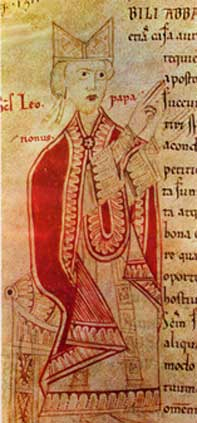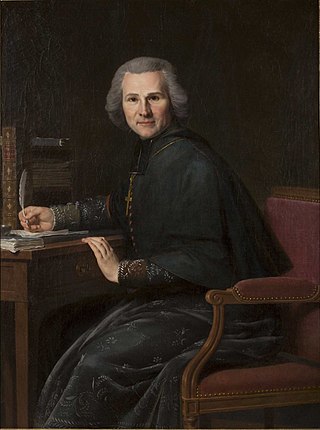Related Research Articles

Pope Leo IX, born Bruno von Egisheim-Dagsburg, was the head of the Catholic Church and ruler of the Papal States from 12 February 1049 to his death in 1054. Leo IX is considered to be one of the most historically significant popes of the Middle Ages; he was instrumental in the precipitation of the Great Schism of 1054, considered the turning point in which the Catholic and Eastern Orthodox Churches formally separated.

Georges Darboy was a French Catholic priest, later bishop of Nancy then archbishop of Paris. He was among a group of prominent hostages executed as the Paris Commune of 1871 was about to be overthrown.

Henri Jean-Baptiste Grégoire, often referred to as the Abbé Grégoire, was a French Catholic priest, constitutional bishop of Blois and a revolutionary leader. He was an ardent slavery abolitionist and supporter of universal suffrage. He was a founding member of the Bureau des longitudes, the Institut de France, and the Conservatoire national des arts et métiers.

Jean de Lorraine was the third son of the ruling Duke of Lorraine, and a French cardinal, who was archbishop of Reims (1532–1538), Lyon (1537–1539), and Narbonne (1524–1550), bishop of Metz, and Administrator of the dioceses of Toul, Verdun, Thérouanne, Luçon, Albi, Valence, Nantes and Agen (1538–1550). He was a personal friend, companion, and advisor of King Francis I of France. Jean de Lorraine was the richest prelate in the reign of Francis I, as well as the most flagrant pluralist. He is one of several cardinals known as the Cardinal de Lorraine.
Ado of Vienne was archbishop of Vienne in Lotharingia from 850 until his death and is venerated as a saint. He belonged to a prominent Frankish family and spent much of his early adulthood in Italy. Several of his letters are extant and reveal their writer as an energetic man of wide sympathies and considerable influence. Ado's principal works are a martyrology, and a chronicle, Chronicon sive Breviarium chronicorum de sex mundi aetatibus de Adamo usque ad annum 869.

The Archdiocese of Reims is a Latin Church ecclesiastic territory or archdiocese of the Catholic Church in France. Erected as a diocese around 250 by St. Sixtus of Reims, the diocese was elevated to an archdiocese around 750. The archbishop received the title "primate of Gallia Belgica" in 1089.

Nicolas of Lorraine, Duke of Mercœur, was the second son of Antoine, Duke of Lorraine, and Renée de Bourbon.

Antoine Augustin Calmet, O.S.B., a French Benedictine monk, was born at Ménil-la-Horgne, then in the Duchy of Bar, part of the Holy Roman Empire.

The Diocese of Nancy and Toul is a Latin Church ecclesiastical territory or diocese of the Catholic Church in France. After a considerable political struggle between Louis XV, Louis XVI, and the Dukes of Lorraine, the diocese was erected by Pope Pius VI on 17 December 1777. The Diocese of Nancy is a suffragan diocese in the ecclesiastical province of the metropolitan Archdiocese of Besançon.

Saint Mansuetus was the first Bishop of Toul.

Henry of Marcy, or Henri de Marsiac, was a Cistercian abbot, first of Hautecombe in Savoy (1160–1177), and then of Clairvaux, from 1177 until 1179. He was created Cardinal Bishop of Albano by Pope Alexander III at the Third Lateran Council in 1179.
Auspicius of Toul was a 5th-century bishop of Toul, the fifth of those recorded, and a saint of the Roman Catholic church. He was also a poet, known for iambic verse based on stress ; this was an innovation of his time. A verse letter of his from around 470 to Arbogast, count of Trier, survives.
The Sisters of the Christian Doctrine of Nancy (D.C.) is a religious order of the Roman Catholic Church for women, whose primary mission is the teaching and nursing of the poor. Its members place after their names the order's initials, D.C. They are known as the "Vatelottines" in honor of their founder, and also "School Sisters", especially in Germany and Luxembourg, because of their primary mission. They should not be confused with the Spanish order of the Sisters of the Christian Doctrine (Mislata), which was founded in 1880.

Peter of Brixey was Bishop of Toul from 1167 to 1192, and a supporter of the Holy Roman Emperor Frederick Barbarossa in the late twelfth-century phase of the Investiture Controversy, one of the few bishops of Lorraine to do so.
Saint Ursus of Toul, known in French as Saint Ours, was a 5th-century French bishop of Toul and a saint of the Roman Catholic Church with a locally venerated feast day celebrated on 1 March.
Saint Alchas was the third bishop of Toul. He is venerated as a saint by the Roman Catholic Church.
Saint Albaud of Toul, otherwise Aladius or Albin was a 6th-century bishop of Toul. He is venerated as a saint in the Catholic church with a feast day celebrated on 1 March.
Trifsorich or Trisorik of Toul was the 9th bishop of Toul. Trifsorich succeeded Albaud of Toul in 525, but very little is known about him.
Berthold, Bertholde or Bertholdus of Toul was a German Roman Catholic clergyman.

Rolandus was a cardinal of the Roman Catholic Church. He was a native of Pisa, not Siena or Brittany. He was elected archbishop of Dol, but was not consecrated for five years, due to the opposition his metropolitan, the archbishop of Tours. Before he became a cardinal, he was sent by Pope Lucius III as his representative to Scotland to attempt to resolve a dispute over episcopal elections, involving the king.
References
- ↑ A. D. Thierry, Histoire de la ville de Toul et de ses évêques, Paris, 1841, pp. 35-37
- ↑ J.P. Migne, Nouvelle encyclopédie théologique, vol. 9, 1851, pp. 423-424.
- ↑ Abbé Pierre-Etienne Guillaume, Histoire du diocèse de Toul et de celui de Nancy, vol. 1, Nancy, 1867, p. 105.
- ↑ in either Corpus Christianorum Continuatio Mediaeualis, vol 45, ed. D. Verhelst (Turnhout, 1976),[ page needed ] or J.-P. Migne, Patrologia Latina , CXXXVI, 589-60.[ page needed ]